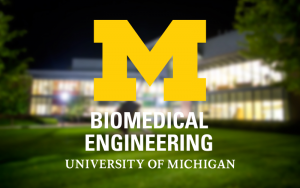Presented By: Biomedical Engineering
PhD Defense: Tianrui Luo
MRI Excitation Pulse Design and Image Reconstruction for Accelerated Neuroimaging

NOTICE: This event will be held via Zoom. The link will be placed below.
https://umich.zoom.us/j/92217348735
Excitation pulse design and image reconstruction are two important topics in MR research for enabling faster imaging. On the pulse design side, selective excitations that confine signals to be within a small region-of-interest (ROI) instead of the full imaging field-of-view (FOV) can be used to reduce sampling density in the k-space, which is a direct outcome of the change in the underlying Nyquist sampling rate. On the reconstruction side, besides improving imaging algorithms’ ability to restore images from less data, another objective is to reduce the reconstruction time, particularly for dynamic imaging applications.
This dissertation focuses on these two perspectives: The first part is devoted to the excitation pulse design. Specifically, we derived and developed a computationally efficient auto-differentiable Bloch-simulator and its explicit Bloch simulation Jacobian operations. This simulator can yield numerical derivatives with respect to pulse RF and gradient waveforms given arbitrary subdifferentiable excitation objective functions. We successfully applied this pulse design approach for jointly designing RF and gradient waveforms for 3D spatially tailored large-tip excitation objectives.
The auto-differentiable pulse design method can yield superior 3D spatially tailored excitation profiles that are useful for inner volume (IV) imaging. We propose and develop a novel steady-state IV imaging strategy which suppresses aliasing by saturating the outer volume (OV) magnetizations via a 3D tailored OV excitation pulse that is followed by a signal crusher gradient. This method substantially suppresses the unwanted OV aliasing for common steady-state imaging sequences.
The second part focuses on non-iterative image reconstruction. In dynamic imaging (e.g., fMRI), where a time series is to be reconstructed, such algorithms may offer savings in overall reconstruction time. We extend the conventional GRAPPA algorithm to work efficiently for general non-Cartesian acquisitions. It attains reconstruction quality that can rival classical iterative imaging methods such as conjugate gradient SENSE and SPIRiT.
In summary, this dissertation has proposed and developed multiple methods for accelerating MR imaging, from pulse design to reconstruction. While devoted to neuroimaging, the proposed methods are general and should also be useful for other applications.
https://umich.zoom.us/j/92217348735
Excitation pulse design and image reconstruction are two important topics in MR research for enabling faster imaging. On the pulse design side, selective excitations that confine signals to be within a small region-of-interest (ROI) instead of the full imaging field-of-view (FOV) can be used to reduce sampling density in the k-space, which is a direct outcome of the change in the underlying Nyquist sampling rate. On the reconstruction side, besides improving imaging algorithms’ ability to restore images from less data, another objective is to reduce the reconstruction time, particularly for dynamic imaging applications.
This dissertation focuses on these two perspectives: The first part is devoted to the excitation pulse design. Specifically, we derived and developed a computationally efficient auto-differentiable Bloch-simulator and its explicit Bloch simulation Jacobian operations. This simulator can yield numerical derivatives with respect to pulse RF and gradient waveforms given arbitrary subdifferentiable excitation objective functions. We successfully applied this pulse design approach for jointly designing RF and gradient waveforms for 3D spatially tailored large-tip excitation objectives.
The auto-differentiable pulse design method can yield superior 3D spatially tailored excitation profiles that are useful for inner volume (IV) imaging. We propose and develop a novel steady-state IV imaging strategy which suppresses aliasing by saturating the outer volume (OV) magnetizations via a 3D tailored OV excitation pulse that is followed by a signal crusher gradient. This method substantially suppresses the unwanted OV aliasing for common steady-state imaging sequences.
The second part focuses on non-iterative image reconstruction. In dynamic imaging (e.g., fMRI), where a time series is to be reconstructed, such algorithms may offer savings in overall reconstruction time. We extend the conventional GRAPPA algorithm to work efficiently for general non-Cartesian acquisitions. It attains reconstruction quality that can rival classical iterative imaging methods such as conjugate gradient SENSE and SPIRiT.
In summary, this dissertation has proposed and developed multiple methods for accelerating MR imaging, from pulse design to reconstruction. While devoted to neuroimaging, the proposed methods are general and should also be useful for other applications.